* How to transport the sample interface and control application codes presented in the
book to other microcontrollers
* The amazing software development capabilities of MPLAB and PICC Lite C programming
language compiler (both included on the CD-ROM)
* The Microchip PICmicro PIC16F627 which can be erased and reprogrammed with simple
hardware
The CD-ROM includes
* PICMicro Instruction Set Reference * Selected PICMicro MCU datasheets * Microchip MPLAB
software and documentation * El Cheapo programmer software and building instructions *
PICC-Lite Compiler Software and documentation * Source code for sample applications * HTML
links
The "Robot DNA" series has become an absolutely essential
addition to every amateur roboticist's bookshelf. Start your collection today with Programming
Robot Controllers.

123 PIC Microcontroller Experiments for
the Evil Genius

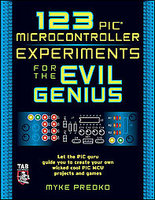 More than just hours of fun, these exciting experiments provide a
solid grounding in PIC microcontrollers and the skills needed to program
them -- from the ground up. Each experiment builds on those before it,
so you develop a hands-on, practical understanding of microcontroller
programming. You don't need any knowledge of programming to get started.
But by the end, you'll be able to complete your own awesome projects!. More than just hours of fun, these exciting experiments provide a
solid grounding in PIC microcontrollers and the skills needed to program
them -- from the ground up. Each experiment builds on those before it,
so you develop a hands-on, practical understanding of microcontroller
programming. You don't need any knowledge of programming to get started.
But by the end, you'll be able to complete your own awesome projects!.
123 PIC Microcontroller Projects for the Evil Genius:
* Introduces you to programming and customizing the PIC MCU step-by-step
-- you don't need to be a whiz to get started, but you will be when you
are finished.
* Shows you how to set up your own PIC microcontroller and development lab
based on one inexpensive Microchip starter
kit.
* Vividly explains the science and electronics underlying
microcontrollers.
* Gives you enjoyable step-by-step experiments that build your skills,
one bit at a time.
* Teaches you both C and assembly language.
* Shows you how to interface sensors, switches, LEDs, LCDs, and other
commonly used electronic interfaces.
* Offers step-by-step experiments that develop handy resource routines
in assembly language.
* Challenges you to stretch the limits of PIC MCU applications.
* Supplies parts lists and program listings |
|

Getting Started with Arduino

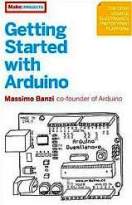 This
valuable little book offers a thorough introduction to the open-source
electronics prototyping platform that's taking the design and hobbyist world
by storm. Getting Started with Arduino gives you lots of ideas for
Arduino projects and helps you get going on them right away. From getting
organized to putting the final touches on your prototype, all the
information you need is right in the book. This
valuable little book offers a thorough introduction to the open-source
electronics prototyping platform that's taking the design and hobbyist world
by storm. Getting Started with Arduino gives you lots of ideas for
Arduino projects and helps you get going on them right away. From getting
organized to putting the final touches on your prototype, all the
information you need is right in the book.
With inexpensive hardware and open-source software components that
you can download free, getting started with Arduino is a snap. To use the
introductory examples in this book, all you need is an
Arduino
Starter Kit.
Join the tens of thousands of hobbyists who have discovered this incredible
(and educational) platform. Getting Started with Arduino gets you in
on the fun!
You'll learn about:
* Interaction design and physical computing
* The Arduino hardware and software development environment
* Basics of electricity and electronics
* Prototyping on a solderless breadboard
* Drawing a schematic diagram |
|

PIC Microcontroller Project Book

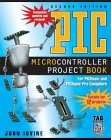 What
can you do with PIC microcontrollers? Practically anything--from creating
"photovore" robots that hunt light to feed their solar cells to making
toasters announce, "Your toast is ready!" These low-cost (around 7 bucks)
computers-on-a-chip let electronics designers and
hobbyists add intelligence, responsiveness, and functions that mimic big
computers to any electronic product or project. What
can you do with PIC microcontrollers? Practically anything--from creating
"photovore" robots that hunt light to feed their solar cells to making
toasters announce, "Your toast is ready!" These low-cost (around 7 bucks)
computers-on-a-chip let electronics designers and
hobbyists add intelligence, responsiveness, and functions that mimic big
computers to any electronic product or project.
PIC Microcontroller Project Book gives you hands-on directions for putting
PIC chips with up to 8K of memory to work.
Starting with simple projects and experiments, this book leads you gradually
into sophisticated programming techniques. You need absolutely no
programming experience to get started. John Iovine coaches you through every
single step. Written with the beginner in mind, PIC Microcontroller Project
Book gives you A-B-C guidance on how to:
Get the equipment you need (includes lists of suppliers)
Program your chip
Make your chip count numerically
Deliver messages on a liquid crystal display
Synthesize human speech
Control DC motors, stepper motors, and servos
Convert any analog signal to digital
Add sensing abilities to robots
Build decision-making neural and "fuzzy logic" functions into your projects
Written with the beginner in mind, this project-oriented guide gives you twelve
complete projects, including: add sensing abilities to robots, build decision-making
neural and "fuzzy logic" functions into your projects, convert any analog signal
to digital, deliver messages on a LCD, synthesize human speech, control DC motors, stepper
motors, and servos, read resistive sensors for robotics applications, build a frequency
generator, make a DTMF phone number logger and distinct ring detector and router, build a
digital oscilloscope, and home automation using X-10 communications.
The PIC microcontroller is enormously popular both in the U.S. and abroad.
The first edition of this book was a tremendous success because of that.
However, since the book was first published, the electronics hobbyist market
has become more sophisticated. This new edition is fully updated and revised.

The Microcontroller Idea Book

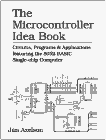 The
Microcontroller Idea Book is a how-to for the 8052-BASIC single-chip
computer. Practical designs for use in data loggers, controllers, and other
small-computer applications. How to use sensors, relays, displays, clocks/calendars,
keypads, wireless links, and more. Complete with schematics, example programs and
design theory. Use the described development system for easy, inexpensive testing and
EPROM programming. The
Microcontroller Idea Book is a how-to for the 8052-BASIC single-chip
computer. Practical designs for use in data loggers, controllers, and other
small-computer applications. How to use sensors, relays, displays, clocks/calendars,
keypads, wireless links, and more. Complete with schematics, example programs and
design theory. Use the described development system for easy, inexpensive testing and
EPROM programming.

PIC Robotics

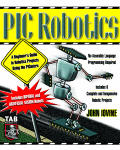 Here's everything the robotics hobbyist needs to harness the power
of the PIC Microcontroller! Over the past 5 years, dramatic improvements in technologies
and significant cost reductions in 8-bit microprocessors have spawned a renaissance in
robot building. PIC Robotics, from popular electronics hobbies author John
Iovine, shows amateur (and professional) enthusiasts how to get in on the fun, using the
power of Microchip's versatile 8-bit PIC microprocessor family to build sophisticated
robots more cheaply and easily than you thought possible. Here's everything the robotics hobbyist needs to harness the power
of the PIC Microcontroller! Over the past 5 years, dramatic improvements in technologies
and significant cost reductions in 8-bit microprocessors have spawned a renaissance in
robot building. PIC Robotics, from popular electronics hobbies author John
Iovine, shows amateur (and professional) enthusiasts how to get in on the fun, using the
power of Microchip's versatile 8-bit PIC microprocessor family to build sophisticated
robots more cheaply and easily than you thought possible.
In this heavily-illustrated resource, author John Iovine provides plans
and complete parts lists for 11 easy-to-build robots each with a PICMicro brain. The
expertly written coverage of the PIC Basic Computer makes programming a snap -- and lots
of fun.
Build your own robots with step-by-step directions for several complete
projects including:
• A bi-pedal robot that walks upright
• Functional robotic arms
• Easily programmed behavioral based robots
• Complete parts lists for all projects
• Inspiration for hundreds more
With PIC Robotics, you can build robots that--
• Follow a line
• Look for light
• Track a scent
• Play tag
• Perform hand and arm functions
• Fly, swim, crawl, or slither

Programming and Customizing the Basic Stamp Computer
with CD-ROM

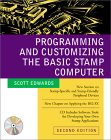 Programming and Customizing the Basic
Stamp, Second Edition gives you a comprehensive tutorial on the easy-to-use BASIC Stamp single-board computer, which runs a PIC
Microcontroller, and doesn't require you to do any assembly language programming. Programming and Customizing the Basic
Stamp, Second Edition gives you a comprehensive tutorial on the easy-to-use BASIC Stamp single-board computer, which runs a PIC
Microcontroller, and doesn't require you to do any assembly language programming.
This new edition moves you briskly from electronic foundations through
BASIC Stamp "Boot Camps" and an intelligent traffic signal simulation to build a
robotic bug with whisker sensors, a time/temperature display, and a data-logging
thermometer.
Written by Scott Edwards, the original author of the widely read
"Stamp Applications" column for Nuts & Volts magazine, this
easy-to-follow reference includes a CD that gives you all the IBM- compatible software
tools necessary to begin developing Stamp applications.
Programming and Customizing the BASIC Stamp Computer offers you:
* A primer on basic electronics--including reading schematics, identifying components, and
constructing prototypes.
* Thorough yet accessible coverage of both BASIC Stamp I and II--from reading and
understanding BASIC programs, to PBASIC toolboxes, to detailed applications.
* BASIC Stamp Quick Reference Guide
* 12 complete projects that demonstrate various BASIC Stamp applications and allow you to
put your new knowledge to work.
* An accompanying CD that provides all the software tools you need to begin developing PIC
applications on your own.
New in this edition:
*Coverage of Stamp-specific and Stamp-friendly peripheral devices
*Chapter on using the BS2-SX
*Bonus projects
With the range of skills you'll develop using this guide, you'll see why it can be easier
to build sophisticated projects with microcontrollers than with conventional electronic
parts--and even more fun!
|
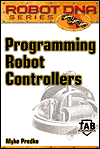 Programming
Robot Controllers is the second volume in the new "Robot DNA" series by
McGraw-Hill/TAB Electronics.
Programming
Robot Controllers is the second volume in the new "Robot DNA" series by
McGraw-Hill/TAB Electronics. More than just hours of fun, these exciting experiments provide a
solid grounding in PIC microcontrollers and the skills needed to program
them -- from the ground up. Each experiment builds on those before it,
so you develop a hands-on, practical understanding of microcontroller
programming. You don't need any knowledge of programming to get started.
But by the end, you'll be able to complete your own awesome projects!.
More than just hours of fun, these exciting experiments provide a
solid grounding in PIC microcontrollers and the skills needed to program
them -- from the ground up. Each experiment builds on those before it,
so you develop a hands-on, practical understanding of microcontroller
programming. You don't need any knowledge of programming to get started.
But by the end, you'll be able to complete your own awesome projects!. What
can you do with PIC microcontrollers? Practically anything--from creating
"photovore" robots that hunt light to feed their solar cells to making
toasters announce, "Your toast is ready!" These low-cost (around 7 bucks)
computers-on-a-chip let electronics designers and
hobbyists add intelligence, responsiveness, and functions that mimic big
computers to any electronic product or project.
What
can you do with PIC microcontrollers? Practically anything--from creating
"photovore" robots that hunt light to feed their solar cells to making
toasters announce, "Your toast is ready!" These low-cost (around 7 bucks)
computers-on-a-chip let electronics designers and
hobbyists add intelligence, responsiveness, and functions that mimic big
computers to any electronic product or project. The
Microcontroller Idea Book is a how-to for the 8052-BASIC single-chip
computer. Practical designs for use in data loggers, controllers, and other
small-computer applications. How to use sensors, relays, displays, clocks/calendars,
keypads, wireless links, and more. Complete with schematics, example programs and
design theory. Use the described development system for easy, inexpensive testing and
EPROM programming.
The
Microcontroller Idea Book is a how-to for the 8052-BASIC single-chip
computer. Practical designs for use in data loggers, controllers, and other
small-computer applications. How to use sensors, relays, displays, clocks/calendars,
keypads, wireless links, and more. Complete with schematics, example programs and
design theory. Use the described development system for easy, inexpensive testing and
EPROM programming. Here's everything the robotics hobbyist needs to harness the power
of the PIC Microcontroller! Over the past 5 years, dramatic improvements in technologies
and significant cost reductions in 8-bit microprocessors have spawned a renaissance in
robot building. PIC Robotics, from popular electronics hobbies author John
Iovine, shows amateur (and professional) enthusiasts how to get in on the fun, using the
power of Microchip's versatile 8-bit PIC microprocessor family to build sophisticated
robots more cheaply and easily than you thought possible.
Here's everything the robotics hobbyist needs to harness the power
of the PIC Microcontroller! Over the past 5 years, dramatic improvements in technologies
and significant cost reductions in 8-bit microprocessors have spawned a renaissance in
robot building. PIC Robotics, from popular electronics hobbies author John
Iovine, shows amateur (and professional) enthusiasts how to get in on the fun, using the
power of Microchip's versatile 8-bit PIC microprocessor family to build sophisticated
robots more cheaply and easily than you thought possible.  Programming and Customizing the Basic
Stamp, Second Edition gives you a comprehensive tutorial on the easy-to-use BASIC Stamp single-board computer, which runs a PIC
Microcontroller, and doesn't require you to do any assembly language programming.
Programming and Customizing the Basic
Stamp, Second Edition gives you a comprehensive tutorial on the easy-to-use BASIC Stamp single-board computer, which runs a PIC
Microcontroller, and doesn't require you to do any assembly language programming.